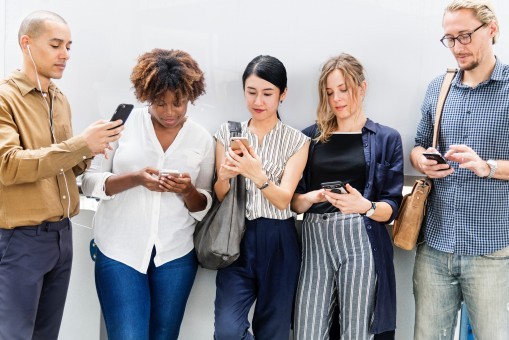|
Do you receive those notifications telling you how many hours on average you’ve spent on your phone? Have you felt a tinge of guilt after looking at them?
A client* recently shared: “How have I spent 7 hours in one day on my phone? I work using my computer!” She embarked on a task to track how she was using her phone and in the process she gained more focus and awareness!

I’ll share the culprit… the repeat habit of reaching for the phone during “waiting” moments—whether it’s a break between meetings, being on a bus, or waiting for the tea to brew. According to a recent article by CNBC, quoting cell phone usage statistics by reviews.com, the average American checks their phone 205 times a day, or almost once every five minutes while awake.
If one spends 4 hours on the phone every day, that's the equivalent of over 1 day per week or 5 days per month. Across a year, that's approximately 60 days spent looking at a phone!
But here’s the thing: phones aren’t inherently bad. They connect us to people we love, give us instant access to information, and help us manage day-to-day tasks. The challenge arises when we start to lose control over how much time we spend using our phone. They then become an appendage of ourselves! That’s when it can start to have a negative effect on our mental well-being, our relationships, our work, and even our ability to be present and enjoy life in the moment.
So, What can we do? A Simple Practice: The 24-Hour Challenge
Christine Rosen, a senior fellow at the American Enterprise Institute, developed a simple but powerful exercise to help us break the cycle of mindless phone use. It’s called the 24-Hour Phone Break Challenge. The concept is straightforward: for one full day, don’t reach for your phone during the “in-between” moments—those times when you’re waiting for something else to happen, like waiting to see the doctor or during a break between tasks. These moments, which Rosen calls interstitial moments, are often where we mindlessly grab our phones to fill time.
You might think this is a simple exercise but believe me—it’s harder than it sounds.
Why It's Difficult
The reality is, our phones are designed to keep us hooked. Every ping, notification, and message is a tiny hit of dopamine, making it hard not to check our devices even during moments when we should be giving our brains a break. But this is exactly why this exercise is so effective. By resisting the urge to fill every idle moment with our phones, we begin to reconnect with the present, with our thoughts, and with the world around us.
Christine Rosen shared with the HuffPost that this simple practice made her realize something important: she wasn’t paying attention to her surroundings or giving herself the mental space to relax and recharge. She explained, “What this challenge did for me was help me realize I wasn’t noticing what was going on around me. I wasn’t giving my brain the break it needed.”
And that’s the key takeaway: when we stop letting our phones consume every spare moment, we make room for something more valuable—awareness. That’s precisely what my client discovered when she started keeping her phone in her purse or leaving it in another room.
Wins for Your Emotional Health
This challenge is not just a way to reduce screen time; it’s a tool for better emotional well-being.
Our brains aren’t meant to deal with constant stimulation. Overstimulation, especially from our phones, can lead to anxiety and overwhelm. In today’s digital age we’re constantly bombarded by information. By allowing ourselves moments of "nothingness," we give our minds a space to recover. As Rosen points out, boredom is often seen as unproductive, but it is actually linked to creativity and emotional processing. By allowing ourselves small, quiet moments throughout the day, we give our mind the time it needs to process thoughts and emotions—something our phones often distract us from.
Be with Your Thoughts
One of the most important aspects of this 24-hour challenge is learning to be present with your thoughts. Often, we use our phones to avoid uncomfortable feelings—whether it’s anxiety, frustration, or even boredom. But allowing yourself to experience these emotions, without rushing to distract yourself, is key to developing emotional strength and calm.
Licensed therapist and author of Mediatox, Jenny Wise, refers to these “micromoments” of boredom as essential for our mental health. “Our mental health is fortified and strengthened by these moments of stillness,” she says.
Step by Step
Yes, small, consistent steps, those small choices we make every day do add up. That extra five minutes of phone-free time while waiting for your train may seem insignificant, but over time, these moments of presence will make a significant difference in how you feel.
I encourage you to try this simple exercise for 24 hours and see how it feels. Disconnecting for just one day might be the first step toward a more mindful life. And who knows? It might even inspire you to take more breaks from your phone moving forward. You may even enjoy receiving notifications about how your time usage has improved!

Here’s to more moments of nothingness.
With gratitude,
Ana Isabel Sánchez
* The client authorized me to share her story.
   
|